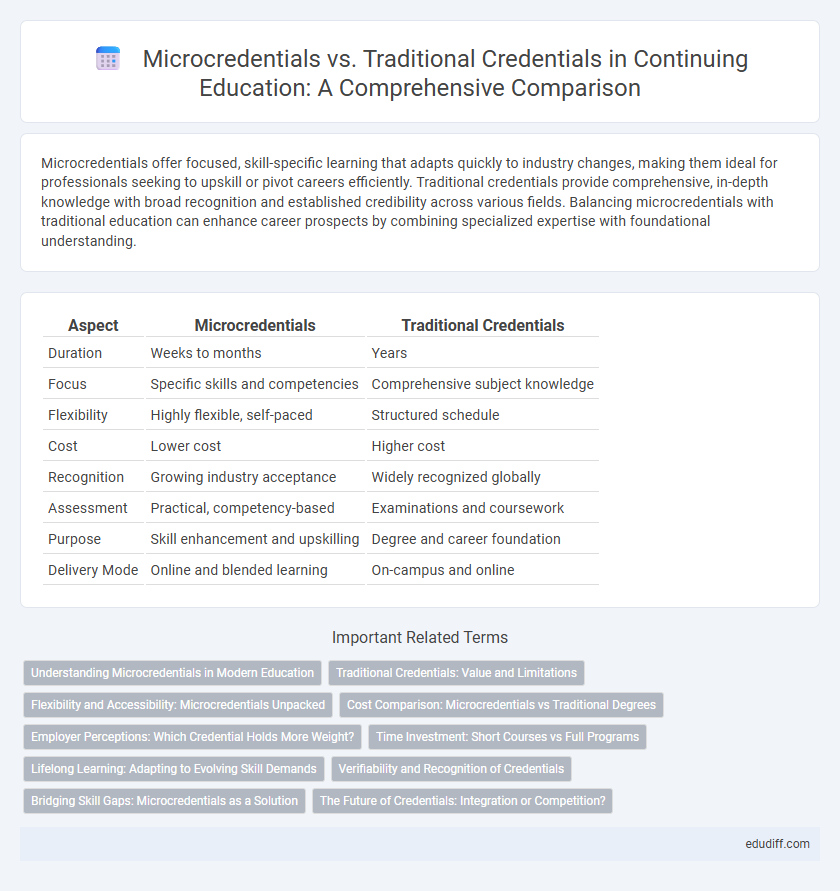Microcredentials offer focused, skill-specific learning that adapts quickly to industry changes, making them ideal for professionals seeking to upskill or pivot careers efficiently. Traditional credentials provide comprehensive, in-depth knowledge with broad recognition and established credibility across various fields. Balancing microcredentials with traditional education can enhance career prospects by combining specialized expertise with foundational understanding.
Table of Comparison
| Aspect | Microcredentials | Traditional Credentials |
|---|---|---|
| Duration | Weeks to months | Years |
| Focus | Specific skills and competencies | Comprehensive subject knowledge |
| Flexibility | Highly flexible, self-paced | Structured schedule |
| Cost | Lower cost | Higher cost |
| Recognition | Growing industry acceptance | Widely recognized globally |
| Assessment | Practical, competency-based | Examinations and coursework |
| Purpose | Skill enhancement and upskilling | Degree and career foundation |
| Delivery Mode | Online and blended learning | On-campus and online |
Understanding Microcredentials in Modern Education
Microcredentials offer targeted skill validation that aligns with rapidly evolving industry demands, providing learners with flexible and accessible options beyond traditional degree programs. These stackable credentials emphasize competency-based learning, allowing individuals to demonstrate specific knowledge and abilities through digital badges or certificates. In modern education, microcredentials bridge gaps between formal education and workforce requirements, enhancing employability and lifelong learning opportunities.
Traditional Credentials: Value and Limitations
Traditional credentials, such as degrees and diplomas, provide recognized validation of knowledge and skills often required for professional licensing and advanced academic opportunities. Their value lies in widespread employer acceptance and established academic rigor, but they frequently involve lengthy time commitments and higher costs. Limitations include limited flexibility, slower adaptation to industry changes, and potential barriers for lifelong learners seeking continuous upskilling.
Flexibility and Accessibility: Microcredentials Unpacked
Microcredentials offer unparalleled flexibility by allowing learners to acquire specific skills at their own pace, often through online platforms, making education more accessible to diverse demographics. Unlike traditional credentials that require long-term commitments and rigid schedules, microcredentials accommodate working professionals and lifelong learners seeking targeted competencies. This modular approach breaks down barriers related to time, location, and financial constraints, democratizing skill acquisition in today's rapidly evolving job market.
Cost Comparison: Microcredentials vs Traditional Degrees
Microcredentials typically offer a more affordable alternative to traditional degrees, with costs ranging from a few hundred to a few thousand dollars compared to the tens of thousands often associated with bachelor's or master's programs. They provide focused, skill-specific training without the additional expenses of campus fees, textbooks, or lengthy program durations. This cost efficiency enables learners to upskill quickly and affordably, making microcredentials a viable option for budget-conscious individuals seeking professional advancement.
Employer Perceptions: Which Credential Holds More Weight?
Employers increasingly value microcredentials for their demonstration of specific, up-to-date skills tailored to industry needs, often perceiving them as more practical compared to traditional degrees. Traditional credentials continue to hold significant weight due to their comprehensive academic foundation and widespread recognition in hiring processes. However, the rising demand for agile learning pathways has elevated the credibility of microcredentials in sectors like technology, healthcare, and finance.
Time Investment: Short Courses vs Full Programs
Microcredentials typically require a significantly lower time investment, often completed within weeks or months, compared to traditional credentials that demand several years of study. These short courses focus on specific skills and knowledge areas, allowing learners to quickly upskill or reskill. Full programs, such as degree courses, provide comprehensive education and broader subject mastery but require extensive time commitment and long-term dedication.
Lifelong Learning: Adapting to Evolving Skill Demands
Microcredentials offer flexible, targeted learning pathways that align with rapidly changing industry needs, enabling professionals to continuously update their skills and stay competitive. Traditional credentials provide foundational knowledge but often lack the adaptability required for lifelong learning in dynamic job markets. Integrating microcredentials with conventional education systems supports ongoing skill development, facilitating career resilience and growth.
Verifiability and Recognition of Credentials
Microcredentials offer enhanced verifiability through blockchain technology and digital badges, enabling instant validation by employers and academic institutions. Traditional credentials rely on centralized issuing bodies, which can delay verification and increase the risk of fraud. The increasing acceptance of microcredentials by universities and industry sectors is driving improved recognition, complementing or even replacing traditional degrees in specific skill areas.
Bridging Skill Gaps: Microcredentials as a Solution
Microcredentials provide targeted training that directly addresses specific skill gaps in rapidly evolving industries, offering a flexible and efficient alternative to traditional credentials. These compact, competency-based certifications enable learners to quickly acquire and demonstrate relevant skills, enhancing employability and workforce adaptability. Employers increasingly recognize microcredentials as valuable indicators of up-to-date expertise, facilitating faster hiring and professional development.
The Future of Credentials: Integration or Competition?
The future of credentials may hinge on the integration of microcredentials with traditional degrees to create a more flexible and personalized education landscape. Institutions are increasingly adopting digital badges and stackable credentials that complement conventional diplomas, enhancing lifelong learning and workforce relevance. This hybrid approach aims to balance the depth of traditional credentials with the specificity and agility of microcredentials, positioning both as collaborative rather than competing pathways.
Microcredentials vs Traditional Credentials Infographic

 edudiff.com
edudiff.com